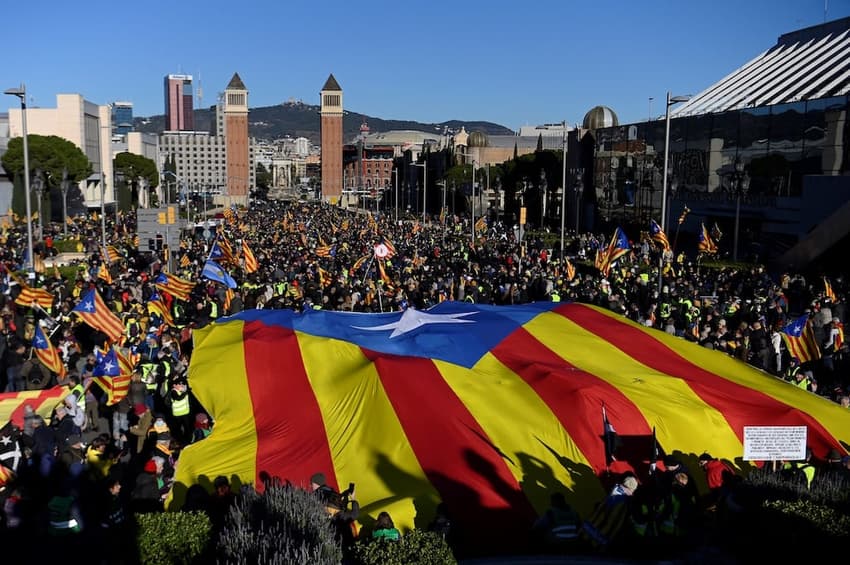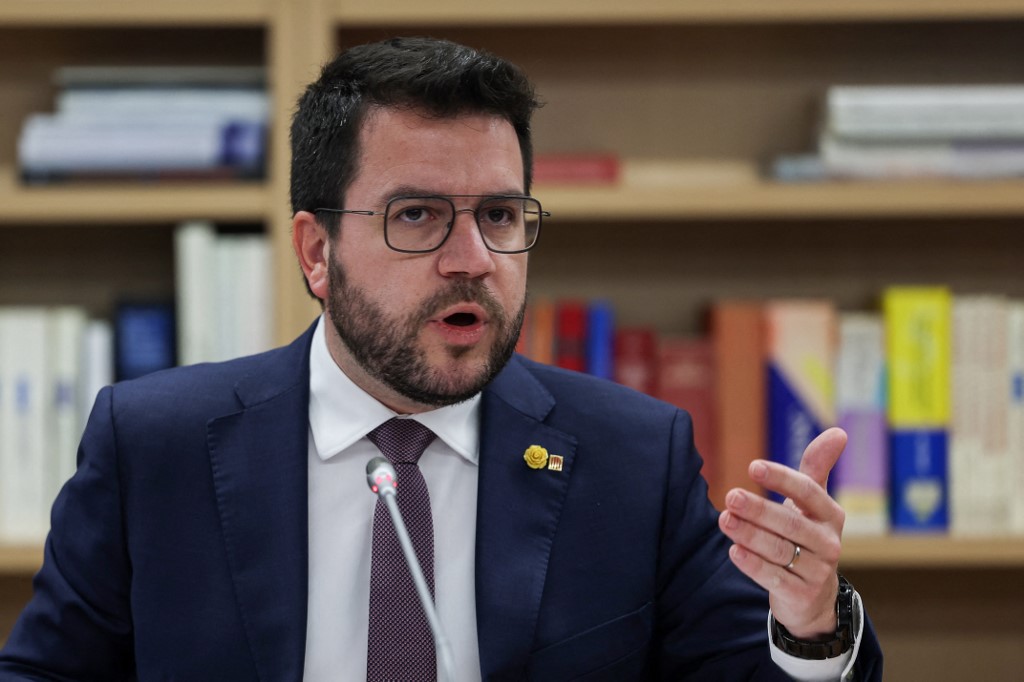La Diada: Seven things you need to know

As crowds prepare to take to the streets for 'La Diada' - Catalan National Day on Monday September 11th. The Local takes a look at what's it all about.
Catalonia's National Day, known locally as La Diada Nacional de Catalunya, is a holiday held in the region every year on September 11th.
More than an occasion to celebrate Catalan culture and customs, however, it has become a day of protest and a chance for those who support the independence movement to demonstrate how they feel.
But why do Catalans celebrate la Diada? What happens during the festival? Read on to find out 7 things you need to know about the big day...
READ ALSO: Ten colourful Catalan phrases you should learn right now
1. It commemorates a famous defeat
Very unusually for a massive holiday, la Diada marks the occasion of a military disaster. Catalan troops fighting the Bourbon King Philip V of Spain during the War of the Spanish Succession were finally defeated on September 11th 1714 after the 14-month Siege of Barcelona. The surrender marked the dissolution of autonomous Catalan institutions, the removal of Catalan as an official language and the imposition of new laws from the newly centralised Spain. Every year, the independence march starts at 17.14 (5:14 pm) to commemorate the date.
2. It was banned by General Franco

The first celebration of La Diada took place in 1886, but it was officially suppressed in 1939 and throughout the dictatorship of Francisco Franco. The Catalan regional government reinstated the fiesta in 1980, five years after Franco's death.
3. It is a tribute to lost Catalan lives
4,000 people died defending the city during the Siege of Barcelona and are buried in a cemetery near the Santa Maria del Mar church in the Gothic Quarter. A memorial plaza, the Fossar de les Moreres, now covers the cemetery and thousands of Catalans lay flowers there every year on La Diada.
4. It's a great day to be a flag seller

La Senyera, the Catalan flag of four red stripes on a yellow background, is everywhere on La Diada. Giant versions are hung across entire buildings while innumerable smaller versions flutter from balconies or are draped across cars. A high percentage of people walking the streets either wear or carry a version of the flag, although many versions on sale are now rather unpatriotically made in China. A slightly different flag, la estelada, is also very popular. It features a white star on a blue triangle (or sometimes a red star on a yellow triangle) over the Senyera's red-and-yellow stripes and is the unofficial symbol of the Catalan independence movement.
5. The day has become more about the independence movement than anything else

Crowds gathering in Barcelona ahead of the start of rally on La Diada. Photo: AFP
La Diada has always been a magnet for supporters of Catalan separatism. For some people, the day is a simple celebration of their Catalan identity, but many others use the occasion to express their political feelings.
The first mass demonstration was held in 2012 when between 600,000 and two million people (depending on whose estimates you believe) gathered in Barcelona to demand independence from Spain. The following year, approximately 1.6 million people joined hands to form an unbroken human chain across the whole region. In the last few years, support for independence has declined, however, and fewer people attend the protests.
6. Organisers use it as a chance for mobilisation

Catalan regional president Pere Aragonès. Photo by Pierre-Philippe Marcou / AFP
This year's event will mark six years since the failed independence referendum in October 2017. Protesters will march down four streets representing the four demands of the independence movement – freedom, language, country and sovereignty – and will all converge on Plaça d'Espanya.
Organisers are keen to show that the region is still committed to breaking away from Spain - a closely-watched survey by the Catalan government's Centro d'Estudis d'Opinio in July 2023 showed that 42 percent of Catalans want an independent state, while 52 percent are now against it.
Catalan president Pere Aragonès has called for people to continue to put pressure on the government this Diada. “Catalonia wants to vote freely on independence, and until the Spanish state responds to this demand democratic, the conflict will exist," he said.
7. Government institutions and museums are free to enter
If you're curious to see inside various Catalan government institutions or you want to learn more about the region and its history and culture, you're in luck as several places are free to visit on La Diada. These include the grand Palau de la Generalitat on Plaça de Sant Jaume, the seat of the Catalan president, and the Parlament de Catalunya (Catalan Parliament) located in the Ciutadella Park.
Certain museums are open too, including the Museu d'Història de Catalunya (Catalan History Museum), the Museu d'Arqueologia de Catalunya (Archeological Museum of Catalonia) and the Museu Nacional d'Art de Catalunya (National Museum of Catalan Art), as well as Gaudí's Palau Güell. Check online at each place before you go as some are free only between certain hours, while others require you to reserve in advance.
Comments
See Also
Catalonia's National Day, known locally as La Diada Nacional de Catalunya, is a holiday held in the region every year on September 11th.
More than an occasion to celebrate Catalan culture and customs, however, it has become a day of protest and a chance for those who support the independence movement to demonstrate how they feel.
But why do Catalans celebrate la Diada? What happens during the festival? Read on to find out 7 things you need to know about the big day...
READ ALSO: Ten colourful Catalan phrases you should learn right now
1. It commemorates a famous defeat
Very unusually for a massive holiday, la Diada marks the occasion of a military disaster. Catalan troops fighting the Bourbon King Philip V of Spain during the War of the Spanish Succession were finally defeated on September 11th 1714 after the 14-month Siege of Barcelona. The surrender marked the dissolution of autonomous Catalan institutions, the removal of Catalan as an official language and the imposition of new laws from the newly centralised Spain. Every year, the independence march starts at 17.14 (5:14 pm) to commemorate the date.
2. It was banned by General Franco

The first celebration of La Diada took place in 1886, but it was officially suppressed in 1939 and throughout the dictatorship of Francisco Franco. The Catalan regional government reinstated the fiesta in 1980, five years after Franco's death.
3. It is a tribute to lost Catalan lives
4,000 people died defending the city during the Siege of Barcelona and are buried in a cemetery near the Santa Maria del Mar church in the Gothic Quarter. A memorial plaza, the Fossar de les Moreres, now covers the cemetery and thousands of Catalans lay flowers there every year on La Diada.
4. It's a great day to be a flag seller

La Senyera, the Catalan flag of four red stripes on a yellow background, is everywhere on La Diada. Giant versions are hung across entire buildings while innumerable smaller versions flutter from balconies or are draped across cars. A high percentage of people walking the streets either wear or carry a version of the flag, although many versions on sale are now rather unpatriotically made in China. A slightly different flag, la estelada, is also very popular. It features a white star on a blue triangle (or sometimes a red star on a yellow triangle) over the Senyera's red-and-yellow stripes and is the unofficial symbol of the Catalan independence movement.
5. The day has become more about the independence movement than anything else

Crowds gathering in Barcelona ahead of the start of rally on La Diada. Photo: AFP
La Diada has always been a magnet for supporters of Catalan separatism. For some people, the day is a simple celebration of their Catalan identity, but many others use the occasion to express their political feelings.
The first mass demonstration was held in 2012 when between 600,000 and two million people (depending on whose estimates you believe) gathered in Barcelona to demand independence from Spain. The following year, approximately 1.6 million people joined hands to form an unbroken human chain across the whole region. In the last few years, support for independence has declined, however, and fewer people attend the protests.
6. Organisers use it as a chance for mobilisation

This year's event will mark six years since the failed independence referendum in October 2017. Protesters will march down four streets representing the four demands of the independence movement – freedom, language, country and sovereignty – and will all converge on Plaça d'Espanya.
Organisers are keen to show that the region is still committed to breaking away from Spain - a closely-watched survey by the Catalan government's Centro d'Estudis d'Opinio in July 2023 showed that 42 percent of Catalans want an independent state, while 52 percent are now against it.
Catalan president Pere Aragonès has called for people to continue to put pressure on the government this Diada. “Catalonia wants to vote freely on independence, and until the Spanish state responds to this demand democratic, the conflict will exist," he said.
7. Government institutions and museums are free to enter
If you're curious to see inside various Catalan government institutions or you want to learn more about the region and its history and culture, you're in luck as several places are free to visit on La Diada. These include the grand Palau de la Generalitat on Plaça de Sant Jaume, the seat of the Catalan president, and the Parlament de Catalunya (Catalan Parliament) located in the Ciutadella Park.
Certain museums are open too, including the Museu d'Història de Catalunya (Catalan History Museum), the Museu d'Arqueologia de Catalunya (Archeological Museum of Catalonia) and the Museu Nacional d'Art de Catalunya (National Museum of Catalan Art), as well as Gaudí's Palau Güell. Check online at each place before you go as some are free only between certain hours, while others require you to reserve in advance.
Join the conversation in our comments section below. Share your own views and experience and if you have a question or suggestion for our journalists then email us at [email protected].
Please keep comments civil, constructive and on topic – and make sure to read our terms of use before getting involved.
Please log in here to leave a comment.